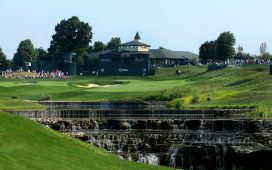Mark Long caddied on the PGA Tour for Fred Funk and other players from 1989 to 2012 and puts together the official yardage books that players and caddies use on PGA Tour courses, including Detroit Golf Club.
Long, 55, recently offered a rundown of how each hole on the North Course will play at the Rocket Mortgage Classic.
The Donald Ross layout is playing at 7,334 yards and par 72 this week.
Hole 1 (par 4, 397 yards)
The two left-side fairway bunkers tighten up the driving area a bit, but there is plenty of room to the right.
Long’s take: “I think you’re going to see a lot of guys hitting a 3-wood or driver off the tee, getting it way down there. It’s a short hole. You’ve got the trees there, but you’re going to blow it over that (fairway) bunker there; it’s not even in play. Get it way down there and a hit a wedge in there. So that’s a birdie hole.”
Hole 2 (par 4, 453 yards)
Out of bounds left and bunkers and pine trees right call for a straight drive. In Donald Ross fashion, the green allows for balls to be bounced onto the putting surface.
Long’s take: “A pretty good raw hole with a tough green. It’s kind of not that close, but it’s close enough that the out of bounds can make you think about it a little bit. So that’s a pretty good hole there. You’d be happy to make four pars there.”
SPORTS FANS: Best credit cards on the market
Hole 3 (par 4, 387 yards)
There are two fairway bunkers that leave an iron shot into this green that slopes drastically from back to front.
Long’s take: “An absolute birdie hole. Guys will just be ripping it way down there and hitting a little flip wedge in.”
Hole 4 (par 5, 635 yards)
A narrow hole that requires an accurate approach shot to the small, contoured green.
Long’s take: “It’s a long par 5, but guys can still reach it in two as long as they hit it, unless the ball’s not rolling at all. So that’s a birdie hole.”
Hole 5 (par 3, 167 yards)
Uphill hole plays slightly longer than the yardage. A back-hole location can produce difficult putting conditions as a spine runs through that area of the green.
Long’s take: “It’s not a long par 3. It’s a pretty good green, like most of them. And you’ve got some steep spill-offs. But you shouldn’t be missing that green.”
Hole 6 (par 4, 461 yards)
For a clear approach to the two-tiered green, the player will need to keep to the left side of the fairway.
Long’s take: “Six is a pretty good hole. It has more of a demanding drive with that bunker on the left. I think it’s got a little length to it, too. Not really a birdie hole, I’d say.”
Hole 7 (par 5, 552 yards)
Players who don’t hit the fairway will have to negotiate a challenging lay-up with a large tree on the left side of the fairway and fairway bunkers short right of the green.
Long’s take: “It’s a real reachable par 5, but you’ve got that big oak tree at the corner coming in there. You’ve got to string a drive there to take advantage of it. So you’ve got to stripe it.”
Hole 8 (par 4, 372 yards)
Several fairway bunkers and out of bounds left may encourage a lay-up short of any trouble. The second shot normally plays about one-half club more to a green that is slightly uphill.
Long’s take: “Eight’s a birdie hole. They’ll be hitting an iron off the tee up onto that plateau and just a little half wedge in there. If guys can reach it 285, 290 front, something like that, they’ll definitely be thinking about (driving the green).”
Hole 9 (par 3, 207 yards)
Slightly downhill hole will play about one-half club shorter than the yardage.
Long’s take: “Nine’s a nice par 3. It seems like it’s kind of a small target.”
Hole 10 (par 4, 425 yards)
Trees left and several fairway bunkers will place a premium on the proper placement of the tee shot.
Long’s take: “They’ll be driving it over the bunkers up there to have another flip wedge. That’ll be another birdie hole.”
Hole 11 (par 3, 233 yards)
The longest of the par 3s is guarded by two bunkers. The green features a front bowl and several places to hide the hole location.
Long’s take: “Eleven’s a good, long par 3. But it won’t be too much of a problem for anybody. Even though the hole’s (about) 225, they’re only hitting a 4-iron anyway. Kind of scary.”
Hole 12 (par 4, 459 yards)
A tee shot that avoids the trees left and a fairway bunker in the driving zone on the right is ideal. The elevated green has a false front.
Long’s take: “Twelve reminds me of six for some reason, although it’s not as tight a tee shot. That’s one of the holes that has a little bit of an elevated green. It shouldn’t be too tough a hole.”
Hole 13 (par 4, 393 yards)
This dogleg right requires a precise tee shot to avoid the trees on the left and fairway bunkers on the right.
Long’s take: “It’s a short hole. It’ll be interesting to see if guys lay back or drive it over the bunkers and try to get it up there. It gets tight. But guys are pretty aggressive nowadays. So you might see lots of guys just taking it over the corner there to have like an 80-yard wedge or something.”
Hole 14 (par 5, 555 yards)
A pond guards the left side of the green and a lay-up can be challenging as players will need to avoid a bunker that crosses the fairway on the right. The green has a large and undulating surface.
Long’s take: “Kind of a fun par 5 that’s kind of wide open, unlike most of the rest of the course off the tee. Just get up and rock it out there and try to reach it. So you’re talking an iron in there if it’s firm at all. It’s a pretty good green, though. It’s got some severe slope on the front left. So you can reach it in two but there’s all kinds of interesting stuff there.”
Hole 15 (par 3, 160 yards)
This hole can play longer than it looks. Bunkers short, left and right guard this small green.
Long’s take: “Fifteen’s just a short, little fun par 3.”
Hole 16 (par 4, 446 yards)
Bunkers guard both sides of the driving zone. The underrated green features subtle breaks.
Long’s take: “Could be kind of a birdie hole, but the bunkers pinch in, making the drive a little more interesting. And I think they’re far enough out there where they’re a tough carry, if I’m not mistaken, for the longer guys.”
Hole 17 (par 5, 577 yards)
Bunker placement throughout this hole requires sound strategy off the tee. A generous opening to the green will allow balls to run onto this undulating putting surface.
Long’s take: “Another fun par 5, kind of like (holes) four and seven, where you can reach it. There’s not really a ton of trouble on it at all.”
Hole 18 (par 4, 455 yards)
A diagonal penalty area will dictate strategy from tee to green. Fairway bunkers are placed on the left and right and the severely sloped green might be the most difficult on the course. A four-putt on this green decided the 1992 U.S. Mid-Amateur championship.
Long’s take: “Eighteen is an interesting tee shot. It’s a decision tee shot. Do I hit it over the bunkers up there? Because I’ve got that penalty area — or ditch or whatever you want to call it — running up the whole left side. You super bring that into play if you hit a driver over the corner there. You could hit a 3-wood out to the right, then you’ve got about a 190-yard shot to a green that’s just like, ‘Hello!’ Talk about a tough green. You could see someone three-putting that one or having trouble with that one to have an effect on that green.”








